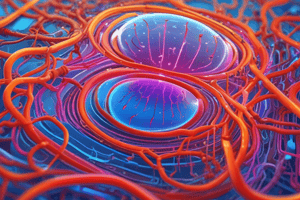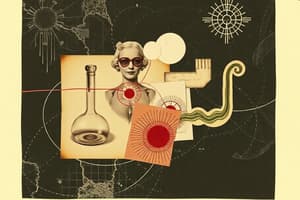Podcast
Questions and Answers
Which characteristic makes microfluidic systems and Bio-MEMS ideal for efficient mass transport?
Which characteristic makes microfluidic systems and Bio-MEMS ideal for efficient mass transport?
- Chips with a small footprint
- Large surface-to-volume ratio (correct)
- Low thermal mass
- Laminar flow
What is a key advantage of using disposable chips in microfluidic systems and Bio-MEMS?
What is a key advantage of using disposable chips in microfluidic systems and Bio-MEMS?
- Low thermal mass
- Laminar flow
- Limited number of platforms
- Cheap production (correct)
Why are microfluidic systems often associated with manageable or limited number of platforms?
Why are microfluidic systems often associated with manageable or limited number of platforms?
- Large surface-to-volume ratio
- Efficient mass transport
- Laminar flow
- Disposable chips (correct)
Which feature of microfluidic systems enables chips and systems with a small footprint?
Which feature of microfluidic systems enables chips and systems with a small footprint?
In what way does the large surface-to-volume ratio of microfluidic systems contribute to their efficiency?
In what way does the large surface-to-volume ratio of microfluidic systems contribute to their efficiency?
What is a key objective of microfluidic systems mentioned in the text?
What is a key objective of microfluidic systems mentioned in the text?
Which term best describes the handling of small fluid volumes in microfluidic systems?
Which term best describes the handling of small fluid volumes in microfluidic systems?
What is the advantage of chips and systems with a small footprint as discussed in the text?
What is the advantage of chips and systems with a small footprint as discussed in the text?
What characteristic of microfluidic systems helps in achieving laminar flow?
What characteristic of microfluidic systems helps in achieving laminar flow?
How do microfluidic systems benefit from having a low thermal mass?
How do microfluidic systems benefit from having a low thermal mass?
Which of the following is a key advantage of microfluidic systems?
Which of the following is a key advantage of microfluidic systems?
Which of the following flow regimes is typically encountered in microfluidic systems?
Which of the following flow regimes is typically encountered in microfluidic systems?
What is a key advantage of the small footprint of microfluidic chips and systems?
What is a key advantage of the small footprint of microfluidic chips and systems?
Which of the following materials was introduced for microfluidic systems in the 1990s, enabling rapid prototyping and low-cost fabrication?
Which of the following materials was introduced for microfluidic systems in the 1990s, enabling rapid prototyping and low-cost fabrication?
Which of the following applications was one of the earliest demonstrations of microfluidic technology?
Which of the following applications was one of the earliest demonstrations of microfluidic technology?
Study Notes
Microfluidics Overview
- Microfluidics is an emerging R&D field since 1990
- Microfluidic systems and Bio-MEMS are simple to process and cheap in production
- Disposable chips are used in many cases
- A manageable/limited number of platforms are available
- Many applications are already commercialized
- Main application areas include life science and biochemical diagnostics
Introduction to Microfluidic Systems
- TheLotus Effect and Capillary Effect are examples of microfluidics in nature
- Flagella, cilia, and blood flow are other examples of microfluidics in nature
Objectives of Microfluidic Systems
- Fast handling of small fluid volumes
- Small footprint of devices
- Low consumption of (expensive) reagents
- Portable (point-of-use devices)
- Robust
- Easy-to-handle
- Cheap
- Disposable (one-time use)
History of Microfluidics
- 1950: First developments in ink-jet printing technology
- 1978: First immunoassay based on capillary forces (glass chip)
- 1979: First gas chromatography chip in silicon (Stanford University)
- 1990: First high-pressure liquid chromatography chip in silicon/Pyrex glass, introduction of μTAS concept
- 1990s: Micro valves and micro pumps in silicon, paper-based test strips, Abbot iSTAD platform (blood parameter)
- 1993: Introduction of soft-lithography
- 1994: Si-/glass-chip for polymerase-chain-reaction (PCR)
- 1997: First capillary electrophoresis chip in PDMS
- 2000: Introduction of multi-layer soft-lithography
Studying That Suits You
Use AI to generate personalized quizzes and flashcards to suit your learning preferences.
Related Documents
Description
Test your knowledge on the history of microfluidics, including key developments such as the first ink-jet printing technology, immunoassays based on capillary forces, and the introduction of μTAS concept. Explore the milestones that paved the way for advancements in microfluidics technology.




